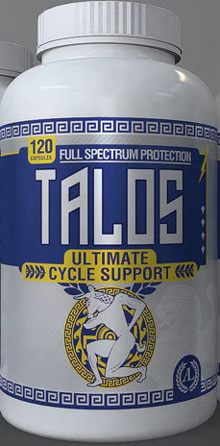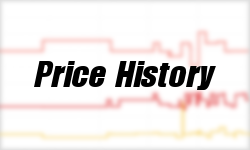
Antaeus Labs Talos
Go to Store
Antaeus Labs Talos
Go to StoreThe Ultimate cycle support supplement from Antaeus labs. Talos was a mythological figure in ancient Greece – a giant man of bronze who protected the shores of Crete from invaders. Now you can harness the power of Talos to support your cardiovascular system.
The Talos formula promotes cardiovascular health in all users, though it is specifically designed to help combat the negative effects of exogenous administration of androgens. Talos seeks to combat the adverse health effects of self-administered anabolic steroids, designer steroids, and prohormones with a combination of antioxidants, vitamins, and potent herbal extracts.
Talos Ingredient Synopsis
Anthocyanins – Sour Cherry extract is loaded with anthocyanins. It has long been known that androgens cause an adverse shift the ratios of lipoproteins; causing an increase in low-density lipoproteins (LDL) and a reduction in high-density lipoproteins (HDL). [1] This is due to an increase in postheparin plasma hepatic triglyceride lipase (HTGL) activity; HTGL is the enzyme responsible for the catabolism of HDL. [2] High LDL and low HDL levels are associated with atherosclerosis and heart disease. Anthocyanins have been shown to increase HDL and reduce LDL concentrations in humans, [3][4] which may be due to the inhibition of plasma cholesteryl ester transfer protein (CETP), an enzyme which transfers cholesterol from HDL cholesterol to very low density or low density lipoproteins. [4] There’s also evidence that the hypolipidemic effects of anthocyanins may be due to increased CYP7A1 expression due to agonism of LXRα. [5]
“Our results suggest that anthocyanin supplementation in dyslipidemic patients has a beneficial effect on the lipoprotein profile, which includes a decrease in LDL-cholesterol and an increase in HDL-cholesterol concentrations.” [4]
Matrine – Soon after the introduction of oral (17a-alkylated) steroids it became apparent that excessive doses or prolonged use can be deleterious to liver function, [6] and since then there have been several case studies of jaundice and liver failure secondary to oral steroid use – both self- administered [7] and in the clinical setting. [8][9] The hepatotoxic effects of oral androgens are of a primarily cholestatic nature. Matrine has been shown in animal models to have a powerful protective effect against cholestasis caused by steroids and other drugs. [10][11]
Trans-Resveratrol – The naturally-occurring grape-derived antioxidant and phytoestrogen trans-resveratrol is believed to be cardioprotective through a number of mechanisms; amongst other things, it inhibits lipid peroxidation, induces vasorelaxation, and limits oxidative damage through the reduction of reactive oxygen species (ROS). [12]
“Resveratrol, a grape polyphenol, has shown considerable promise as a therapeutic agent in the treatment of liver ailments. Several studies have highlighted the hepatoprotective properties of resveratrol. Resveratrol has been shown to prevent hepatic damage because of free radicals and inflammatory cytokines, induce anti-oxidant enzymes and elevate glutathione content.” [13]
9-Cis-B-Carotene – Dunaliella salina extract, containing 10% 9-Cis-Beta Carotene. Beta Carotene is the pigment that gives carrots their orange colour, and is a precursor to vitamin A, which is good for the skin. In the form of 9-Cis-B-Carotene, it is also anti-atherogenic. [14][15]
Salicin – Salicin is a pro-drug to salycilic acid. Administration of anabolic steroids or prohormones enhances platelet aggregation. [16] Salicylic acid decreases platelet aggregation by inhibiting the formation of thromboxane A2, [17] reducing the risk of blood clots, heart attack and stroke.[18]
B9, B6, and B12 – Androgens like testosterone have been shown to increase levels of homocysteine, [19] and the self-administration of anabolic steroids can increase homocysteine levels dramatically. [20] Homocysteine damages the structure of the arteries, and hyperhomocysteinemia (high homocysteine levels) is a strong risk-factor for cardiovascular disease, blood clots, and strokes. [21] Folic acid (B9), pyridoxine (B6), and cobalamin (B12) reduce the levels of homocysteine. [22]
Astaxanthin – Astaxanthin promotes healthy lipid metabolism as an antioxidant, [23] as a PPAR-α agonist, [24] and also by promoting expression of ATP-binding cassette transporters A1 and G1 (ABCA1/G1). [25] ABCA1 and ABCG1 mediate the efflux of cholesterol; helping to remove lipids from cells as the initial step in reverse cholesterol transport (RCT). RCT is the process by which cholesterol is shuttled back to the liver by HDL. [26]
“RCT is a pathway that transports cholesterol from extrahepatic cells and tissues to the liver and intestine for excretion. By reducing accumulation of cholesterol in the wall of arteries, RCT may prevent development of atherosclerosis. Cholesterol efflux, part of the RCT process, is a major process by which macrophages within the vessel wall secrete cholesterol outside cells.” [26]
Cepharanthine – Cepharanthine is a naturally-occurring alkaloid extracted from Stephania cepharantha. It scavenges free radicals, inhibits platelet aggregation, and is anti-inflammatory (through the inhibition of histamine release from mast cells). [27] Furthermore, it is a potent membrane stabilizer; as a plasma membrane stabilizer, it is used clinically (in Japan) for the treatment of snake venom hemolysis and radiation-induced leucopenia. It has also been shown to stabilize the mitochondrial membrane and can protect mitochondria from damage. [28] Lastly, there is evidence to support the assertion that it improves bloodflow to peripheral tissues and organs, and it is also clinically used in Japan for that purpose. [29]
Coenzyme A – Coenzyme A is important to a number of the body’s metabolic functions (like the oxidation of fatty acids). Supplementation has the potential to improve a number of end-points, including acne and triglycerides. [30] Crystalline Coenzyme A is stable for several years at room temperature. [31]
Recommended Dosage
As a dietary supplement, take two capsules in the morning and two in the evening. Take with food, perferably with a high-fat meal. Do not exceed six (6) capsules daily.
References
[1] Krüskemper HL. Anabolic steroids. Academic Press; 1968. p63
[2] Applebaum-Bowden D, Haffner SM, Hazzard WR. The dyslipoproteinemia of anabolic steroid therapy: Increase in hepatic triglyceride lipase precedes the decrease in high density lipoprotein2 cholesterol. Metabolism. 1987 Oct;36(10):949–52.
[3] Zhu Y, Ling W, Guo H, Song F, Ye Q, Zou T, et al. Anti-inflammatory effect of purified dietary anthocyanin in adults with hypercholesterolemia: A randomized controlled trial. Nutr Metab Cardiovasc Dis. 2012 Aug 17;
[4] Qin Y, Xia M, Ma J, Hao Y, Liu J, Mou H, et al. Anthocyanin supplementation improves serum LDL- and HDL-cholesterol concentrations associated with the inhibition of cholesteryl ester transfer protein in dyslipidemic subjects. Am. J. Clin. Nutr. 2009 Sep;90(3):485–92.
[5] Wang D, Xia M, Gao S, Li D, Zhang Y, Jin T, et al. Cyanidin-3-O-β-glucoside upregulates hepatic cholesterol 7α-hydroxylase expression and reduces hypercholesterolemia in mice. Mol Nutr Food Res. 2012 Apr;56(4):610–21.
[6] WERNZE H. Clinical research on the problem of liver damage by certain androgenic and anabolic steroids. Dtsch. Med. Wochenschr. 1960 Dec 16;85:2237–42.
[7] Krishnan PV, Feng Z-Z, Gordon SC. Prolonged intrahepatic cholestasis and renal failure secondary to anabolic androgenic steroid-enriched dietary supplements. J. Clin. Gastroenterol. 2009 Aug;43(7):672–5.
[8] Westaby D, Ogle SJ, Paradinas FJ, Randell JB, Murray-Lyon IM. Liver damage from long-term methyltestosterone. Lancet. 1977 Aug 6;2(8032):262–3.
[9] GORDON BS, WOLF J, KRAUSE T, SHAI F. Peliosis hepatis and cholestasis following administration of norethandrolone. Am. J. Clin. Pathol. 1960 Feb;33:156–65.
[10] Zhai D, Zhao Y, Chen X, Guo J, He H, Yu Q, et al. Protective effect of glycyrrhizin, glycyrrhetic acid and matrine on acute cholestasis induced by alpha-naphthyl isothiocyanate in rats. Planta Med. 2007 Feb;73(2):128– 33.
[11] Zhao Y, Zhai D, He H, Liu J, Li T, Chen X, et al. Matrine improves 17alpha-ethinyl estradiol-induced acute cholestasis in rats. Hepatol Res. 2009 Nov;39(11):1144–9.
[12] Das S, Das DK. Resveratrol: a therapeutic promise for cardiovascular diseases. Recent Pat Cardiovasc Drug Discov. 2007 Jun;2(2):133–8.
[13] Bishayee A, Darvesh AS, Politis T, McGory R. Resveratrol and liver disease: from bench to bedside and community. Liver Int. 2010
Sep;30(8):1103–14.
[14] Harari A, Harats D, Marko D, Cohen H, Barshack I, Kamari Y, et al. A 9-cis beta-carotene-enriched diet inhibits atherogenesis and fatty liver formation in LDL receptor knockout mice. J Nutr. 2008 Oct;138(10):1923– 30.
[15] Shaish A, Daugherty A, O’Sullivan F, Schonfeld G, Heinecke JW. Beta-carotene inhibits atherosclerosis in hypercholesterolemic rabbits. J Clin Invest. 1995 Oct;96(4):2075–82.
[16] Weidemann W, Hanke H. Cardiovascular effects of androgens. Cardiovasc Drug Rev. 2002;20(3):175–98.
[17] Hoak JC. Mechanisms of action: aspirin. Thromb. Res. Suppl. 1983;4:47–51.
[18] Apostolakis S, Marín F, Lip GYH. Antiplatelet therapy in stroke prevention. Adv Cardiol. 2012;47:141–54.
[19] Giltay EJ, Hoogeveen EK, Elbers JMH, Gooren LJG, Asscheman H, Stehouwer CDA. Effects of Sex Steroids on Plasma Total Homocysteine Levels: A Study in Transsexual Males and Females. JCEM. 1998 Feb 1;83(2):550–3.
[20] Ebenbichler CF, Kaser S, Bodner J, Gander R, Lechleitner M, Herold M, et al. Hyperhomocysteinemia in bodybuilders taking anabolic steroids. Eur. J. Intern. Med. 2001 Feb;12(1):43–7.
[21] Lippi G, Plebani M. Hyperhomocysteinemia in health and disease: where we are now, and where do we go from here? Clin. Chem. Lab. Med. 2012 Jun 30;
[22] Olszewski AJ, Szostak WB, Bialkowska M, Rudnicki S, McCully KS. Reduction of plasma lipid and homocysteine levels by pyridoxine, folate, cobalamin, choline, riboflavin, and troxerutin in atherosclerosis. Atherosclerosis. 1989 Jan;75(1):1–6.
[23] Fassett RG, Coombes JS. Astaxanthin, oxidative stress, inflammation and cardiovascular disease. Future Cardiol. 2009 Jul;5(4):333–42.
[24] Jia Y, Kim J-Y, Jun H-J, Kim S-J, Lee J-H, Hoang MH, et al. The natural carotenoid astaxanthin, a PPAR- α agonist and PPAR-γ antagonist, reduces hepatic lipid accumulation by rewiring the transcriptome in lipid- loaded hepatocytes. Mol Nutr Food Res. 2012 Jun;56(6):878–88.
[25] Iizuka M, Ayaori M, Uto-Kondo H, Yakushiji E, Takiguchi S, Nakaya K, et al. Astaxanthin enhances ATP- binding cassette transporter A1/G1 expressions and cholesterol efflux from macrophages. J. Nutr. Sci. Vitaminol. 2012;58(2):96–104.
[26] Ohashi R, Mu H, Wang X, Yao Q, Chen C. Reverse cholesterol transport and cholesterol efflux in atherosclerosis. QJM. 2005 Dec 1;98(12):845–56.
[27] Rogosnitzky M, Danks R. Therapeutic potential of the biscoclaurine alkaloid, cepharanthine, for a range of clinical conditions. Pharmacol Rep. 2011;63(2):337–47.
[28] Nagano M, Kanno T, Fujita H, Muranaka S, Fujiwara T, Utsumi K. Cepharanthine, an anti-inflammatory drug, suppresses mitochondrial membrane permeability transition. Physiol Chem Phys Med NMR. 2003;35(2):131-43.
[29] Chen YQ, Zhao SP, Chen JZ, Lai J. The effects of coenzyme A on serum lipids in patients with hyperlipidemia: results of a multicenter clinical trial. J Clin Endocrinol Metab. 2013;98(2):E275-8.
[30] Buyske DA, Handschumacher RE, Schilling ED, Strong FM. The Stability of Coenzyme A1. J Am Chem Soc. 1954 Jul 1;76(13):3575–7.


